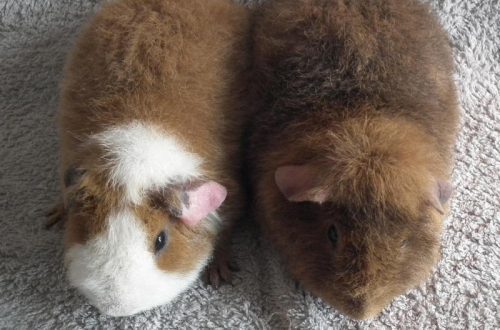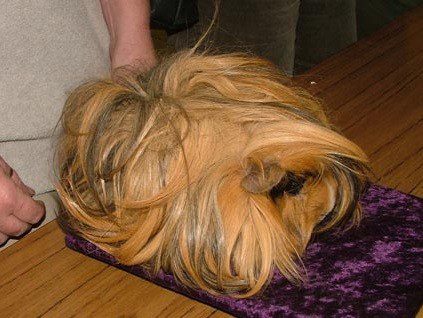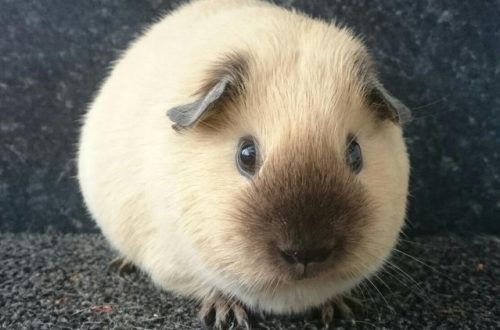
Curly guinea pig
Curly Guinea Pig is a new breed of guinea pig, still quite rare, recently discovered in Sweden. Curly guinea pigs are often called “curly”, very often instead of curly you can find the name “curly guinea pig”. In principle, this is exactly how the word “curly” is translated into Russian.
Curly is, in fact, a short-haired version of the Lunkaria. Just like Lunkaria guinea pigs, Curlies have a dominant gene (which, by the way, is exactly what it is called) that provides the pigs of this breed with curly hair that grows chaotically and gives the pig a funny and comical look.
Curlies are very similar to Rex and Teddy, but the resemblance is all that these breeds have in common. The basis for isolating the Curly into a separate breed was precisely the presence of a dominant gene.
Recall that a dominant gene is a “stronger” gene that ensures the manifestation of one or another trait, regardless of whether the other gene of the same pair is dominant or recessive. A recessive gene, on the contrary, can be suppressed by the influence of a dominant gene. A recessive gene will provide the manifestation of the trait it defines only if it is paired with the corresponding recessive gene. If it is paired with a dominant gene, then it does not appear, since the dominant gene suppresses it.
So, the Curly gene is dominant, while Teddy and Rex are recessive. It is not for nothing that Curly is called the short-haired variant of Lunkaria, since in Lunkaria the “curly” gene is also dominant.
Curly Guinea Pig is a new breed of guinea pig, still quite rare, recently discovered in Sweden. Curly guinea pigs are often called “curly”, very often instead of curly you can find the name “curly guinea pig”. In principle, this is exactly how the word “curly” is translated into Russian.
Curly is, in fact, a short-haired version of the Lunkaria. Just like Lunkaria guinea pigs, Curlies have a dominant gene (which, by the way, is exactly what it is called) that provides the pigs of this breed with curly hair that grows chaotically and gives the pig a funny and comical look.
Curlies are very similar to Rex and Teddy, but the resemblance is all that these breeds have in common. The basis for isolating the Curly into a separate breed was precisely the presence of a dominant gene.
Recall that a dominant gene is a “stronger” gene that ensures the manifestation of one or another trait, regardless of whether the other gene of the same pair is dominant or recessive. A recessive gene, on the contrary, can be suppressed by the influence of a dominant gene. A recessive gene will provide the manifestation of the trait it defines only if it is paired with the corresponding recessive gene. If it is paired with a dominant gene, then it does not appear, since the dominant gene suppresses it.
So, the Curly gene is dominant, while Teddy and Rex are recessive. It is not for nothing that Curly is called the short-haired variant of Lunkaria, since in Lunkaria the “curly” gene is also dominant.

From the history of Curly
Curly pigs are native to Sweden. A similar pig was bred quite recently. Until now, in different sources, you can find conflicting information about which breeds of guinea pigs curlies originated from. Some sources claim that Curly appeared as a result of crossing a lunkaria guinea pig with a short-haired guinea pig. Other sources insist that the Curly is the result of mating between a Teddy and a Rex.
To date, the main distribution area of the Curly is concentrated in Europe; on other continents, these guinea pigs are represented insignificantly.
Curlies are not currently an officially recognized breed of guinea pigs. Breed standards have not yet been developed for them.
Curly pigs are native to Sweden. A similar pig was bred quite recently. Until now, in different sources, you can find conflicting information about which breeds of guinea pigs curlies originated from. Some sources claim that Curly appeared as a result of crossing a lunkaria guinea pig with a short-haired guinea pig. Other sources insist that the Curly is the result of mating between a Teddy and a Rex.
To date, the main distribution area of the Curly is concentrated in Europe; on other continents, these guinea pigs are represented insignificantly.
Curlies are not currently an officially recognized breed of guinea pigs. Breed standards have not yet been developed for them.
Curly Features
Curly guinea pigs are a short-haired breed, although their curly coat looks quite long. Purebred Curlies have a dense, curly, sheep-like coat and pronounced sideburns. Curly’s tummy is also covered with curly hair. The coat may lie close to the body or stand on end, both of which are acceptable. There may be rosettes on the sacrum, but not all Curlies have this feature.
Curly colors can be any, both one-color and with color combinations.
The weight of an adult Curly is approximately 1 kg., Males are usually larger than females. Body length is about 25 cm.
Curly guinea pigs are a short-haired breed, although their curly coat looks quite long. Purebred Curlies have a dense, curly, sheep-like coat and pronounced sideburns. Curly’s tummy is also covered with curly hair. The coat may lie close to the body or stand on end, both of which are acceptable. There may be rosettes on the sacrum, but not all Curlies have this feature.
Curly colors can be any, both one-color and with color combinations.
The weight of an adult Curly is approximately 1 kg., Males are usually larger than females. Body length is about 25 cm.

Curly care and maintenance
Curly care is no different from caring for other guinea pigs. The primary needs are:
- a spacious cage, the minimum allowable area of which, according to experts, should be about 0,6 square meters, which corresponds to the dimensions of 100×60 cm. This requirement is due to the fact that guinea pigs are quite active animals, and they need a lot to maintain the necessary tone and health move, run, walk – in a word, they need space to move around. If the cage is smaller, then this can tell on the health and character of the guinea pig. For more information on what should be the correct cage, read the article “Cage for a guinea pig”;
- a proper diet that includes vegetables and fruits, hay and/or fresh grass, special pellets (dry food) and clean drinking water (for more details, see the Nutrition section). Curlies are a newly bred breed, as mentioned above, and such breeds can often have immune problems and be more prone to various diseases. Therefore, do not forget with vitamin supplements, especially vitamin C.
- regular walks: in the summer – in the fresh air, on the lawn or on the grass, in the winter – around the room.
Do not forget that guinea pigs are social animals, they can only live a full life in a group, therefore the recommended (and in some countries the only acceptable) option for keeping guinea pigs is to keep them in groups.
In groups, they establish their own well-defined hierarchy, special relationships, which are quite interesting to observe. If keeping multiple guinea pigs is problematic (although even just two same-sex guinea pigs is already very good), then give your guinea pig as much attention as possible to help her avoid loneliness.
Your Curly will need occasional brushing and occasional bathing (experts recommend either not bathing guinea pigs at all or several times a year as needed).
Curly care is no different from caring for other guinea pigs. The primary needs are:
- a spacious cage, the minimum allowable area of which, according to experts, should be about 0,6 square meters, which corresponds to the dimensions of 100×60 cm. This requirement is due to the fact that guinea pigs are quite active animals, and they need a lot to maintain the necessary tone and health move, run, walk – in a word, they need space to move around. If the cage is smaller, then this can tell on the health and character of the guinea pig. For more information on what should be the correct cage, read the article “Cage for a guinea pig”;
- a proper diet that includes vegetables and fruits, hay and/or fresh grass, special pellets (dry food) and clean drinking water (for more details, see the Nutrition section). Curlies are a newly bred breed, as mentioned above, and such breeds can often have immune problems and be more prone to various diseases. Therefore, do not forget with vitamin supplements, especially vitamin C.
- regular walks: in the summer – in the fresh air, on the lawn or on the grass, in the winter – around the room.
Do not forget that guinea pigs are social animals, they can only live a full life in a group, therefore the recommended (and in some countries the only acceptable) option for keeping guinea pigs is to keep them in groups.
In groups, they establish their own well-defined hierarchy, special relationships, which are quite interesting to observe. If keeping multiple guinea pigs is problematic (although even just two same-sex guinea pigs is already very good), then give your guinea pig as much attention as possible to help her avoid loneliness.
Your Curly will need occasional brushing and occasional bathing (experts recommend either not bathing guinea pigs at all or several times a year as needed).

So, Curly guinea pigs are a new trend in the world of guinea pigs, a rather rare breed so far. Curly pigs make excellent pets for both experienced breeders and beginner pig breeders. They are quite active, have a good-natured and cheerful character, love to play and run.
So, Curly guinea pigs are a new trend in the world of guinea pigs, a rather rare breed so far. Curly pigs make excellent pets for both experienced breeders and beginner pig breeders. They are quite active, have a good-natured and cheerful character, love to play and run.





